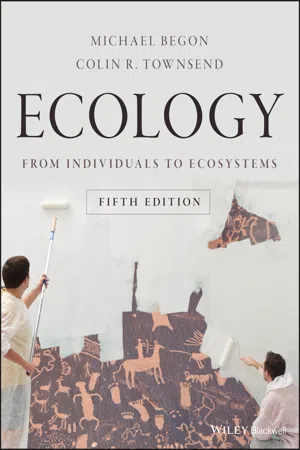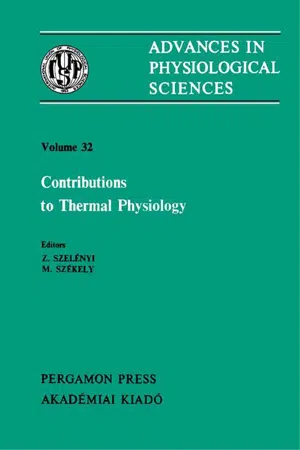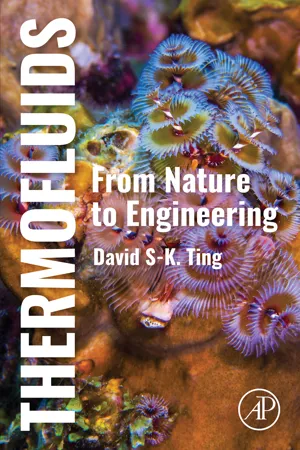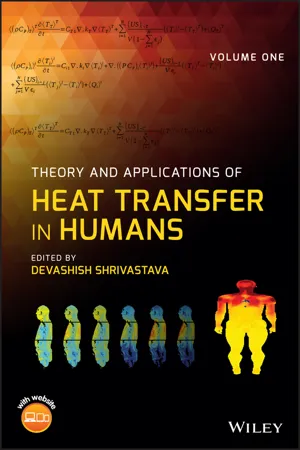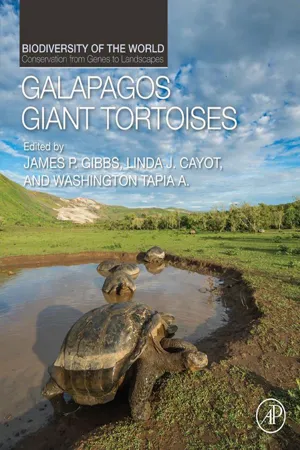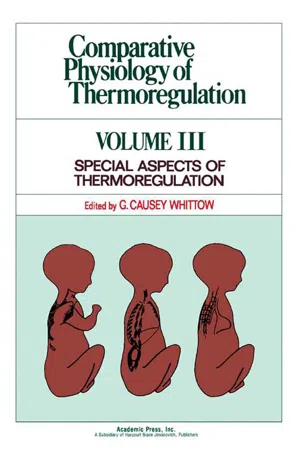Biological Sciences
Endotherm vs Ectotherm
Endotherms are organisms that can regulate their body temperature internally, typically maintaining a relatively constant temperature regardless of external conditions. Ectotherms, on the other hand, rely on external sources of heat to regulate their body temperature and their internal temperature fluctuates with the environment. This distinction is important in understanding how different organisms adapt to and interact with their environments.
Written by Perlego with AI-assistance
Related key terms
12 Key excerpts on "Endotherm vs Ectotherm"
- eBook - ePub
Ecology
From Individuals to Ecosystems
- Michael Begon, Colin R. Townsend(Authors)
- 2020(Publication Date)
- Wiley(Publisher)
But this distinction is not entirely clear‐cut. As we have noted, apart from birds and mammals, there are also other taxa that use heat generated in their own bodies to regulate body temperature, but only for limited periods; and there are some birds and mammals that relax or suspend their endothermic abilities at the most extreme temperatures. In particular, many endothermic animals escape from some of the costs of endothermy by hibernating during the coldest seasons: at these times they behave almost like ectotherms. endotherms: temperature regulation – but at a cost Birds and mammals usually maintain a constant body temperature between 35 and 42°C, and they therefore tend to lose heat in most environments; but this loss is moderated by insulation in the form of fur, feathers and fat, and by controlling blood flow near the skin surface. When it is necessary to increase the rate of heat loss, this too can be achieved by the control of surface blood flow and by a number of other mechanisms shared with ectotherms like panting and the simple choice of an appropriate habitat. Together, all these mechanisms and properties give endotherms a powerful (but not perfect) capability for regulating their body temperature, and the benefit they obtain from this is a constancy of near‐optimal performance. But the price they pay is a large expenditure of energy (Figure 2.12), and thus a correspondingly large requirement for food to provide that energy. Over a certain temperature range (the thermoneutral zone) an endotherm consumes energy at a basal rate. But at environmental temperatures further and further above or below that zone, the endotherm consumes more and more energy in maintaining a constant body temperature - eBook - ePub
Contributions to Thermal Physiology
Satellite Symposium of the 28th International Congress of Physiological Sciences, Pécs, Hungary, 1980
- Z. Szelényi, M. Székely(Authors)
- 2013(Publication Date)
- Pergamon(Publisher)
Phylogenic aspects of temperature regulationPassage contains an image
EVOLUTION FROM ECTOTHERMIA TOWARDS ENDOTHERMIA
A.J. HULBERT, Department of Biology, University of Wollongong, Wollongong, N.S.W., Australia, 2500Publisher Summary
This chapter discusses the evolution from ectothermia toward endothermia. Many reptiles have been shown to possess a rate of heating different to their rate of cooling. It has been shown in a variety of lizards that vasomotor control of blood flow is a significant contributor to this difference between rates of heating and cooling. This has also been demonstrated in the tuatara and in turtles. Measurement of local cutaneous blood flow in a lizard has shown it to increase during heating. In view of the variety of reptiles in which it has been reported, it seems almost certain that the pre-mammalian reptiles possessed this vasomotor ability to alter their body conductance. Endotherms have a high level of metabolism compared to ectotherms. The resting mammal that is undergoing no extra expenditure of energy for thermoregulation will have a level of energy metabolism that is four to five times that of a similar sized resting reptile that is at the same body temperature. Mammals may have larger internal organs than reptiles and thus a larger resting metabolism. The reptile–mammal difference in standard metabolism also exists when levels of maximal metabolism are considered.We mammals, with our relatively constant body temperature possess one of the finest examples of physiological homeostasis being favoured by evolutionary selection. This review will concern itself with the evolutionary sequence in which the many different mechanisms that allow mammals to maintain a constant body temperature have occurred. It is limited to mammals and will also not be concerned with the evolutionary history of the central control of body temperature. Basic thermo-regulatory control is much older than the mammals, since ectothermic vertebrates have both thermal detectors and a central nervous system activator (Hammel 1968). - eBook - ePub
- G. Causey Whittow(Author)
- 1999(Publication Date)
- Academic Press(Publisher)
Development of ThermoregulationA. EmbryoB. HatchlingC. NestlingXIII. SummaryReferencesI INTRODUCTION
Birds are among a minority of animals capable of effective regulatory thermogenesis. Such endothermic capacities are also evident either bodywide or, in some cases, within particular tissues in various insects; some large, fast swimming fish; a few large reptiles; and, of course, mammals. Like the last group, birds show in-pressive homeothermic capacities involving the balancing of rates of thermolysis and thermogenesis. These homeotherms are thus able to regulate body temperature within a narrow range over a wide span of thermal conditions.There is evidence that the high metabolic rates permitting endothermy did not exist in the earliest known bird Archeopteryx lithographica and may not have been completely established in the Class Aves until midlate Cretaceous times. The elevated metabolic levels characterizing modern members of this class may have originally evolved in response to selection for an increased capacity for long-distance flight, rather than as a requisite for flight itself. Endothermic temperature regulation would have been a by-product of this development (Ruben, 1996 ).Despite the fact that homeothermy probably arose independently in the avian and mammalian lines (Ruben, 1995 ), the general features of thermoregulation in the two groups appear quite similar. Nonetheless there are some behavioral and functional differences between them that influence the manner in which this regulation proceeds. Birds, with some important exceptions, appear in winter to make far less use than mammals of the thermal protection provided by underground or subnivian burrows, nests, and cavities in trees. Significantly, seasonal dormancy (hibernation) is rare in birds. However, many of these animals surpass mammals in evasion of adverse thermal conditions by long-distance migration (Dawson et al. , 1983a). The relation between hypothalamic and spinal thermosensitivity differs between these groups (Simon, 1989 ). Furthermore, nonshivering thermogenesis appears absent or less prominent in birds than in the array of mammals possessing brown adipose tissue (Marsh and Dawson, 1989 ; Marsh, 1993 ). There are also differing considerations affecting insulation in the two groups. One relates to the fact that the avian plumage, unlike the mammalian pelage, generally must meet aerodynamic as well as insulative needs. Additionally, distribution of subcutaneous fat tends to be more localized in many birds than in mammals, which affects tissue insulation (Marsh and Dawson, 1989 ). Sweat glands have not been found in the former group and avian cutaneous water loss, which can be substantial (Marder and Gavrieli-Levin, 1987 ), must therefore proceed by a different mechanism than that employed by sweating mammals. Additionally, virtually all birds appear able to enhance respiratory evaporation by panting, whereas this ability is more restricted among mammals. Finally, the contrasting developmental patterns of the two groups (oviparity versus viviparity, excepting the prototherians) have important thermoregulatory implications. The development of the avian egg outside the body of the hen ties one or both parents to the nest and, except for mound builders and brood parasites, necessitates effective incubation patterns serving to maintain embryonic temperature within a narrow range suitable for development. These patterns can expose the incubating parent to extremely demanding thermal conditions (see, for example, Morton, 1978 ; Grant, 1982 - eBook - ePub
Thermofluids
From Nature to Engineering
- David Ting(Author)
- 2022(Publication Date)
- Academic Press(Publisher)
Ganslosser and Jann (2019) . When the environment is warmer than desirable, creatures including humans, apes, monkeys, horses, and hippos sweat. Dogs do not sweat much, instead, they reject heat effectively via evaporative cooling, that is, panting. To stay warm when the environment is colder than thermally comfortable, mammals can increase their body temperature by developing goosebumps, creating added insulation to reduce heat loss.Endotherms are warm-blooded creatures that maintain their body at a metabolically favorable temperature, regardless of the environment. This is achieved primarily by the use of heat released by their internal bodily functions.Ectotherms are cold-blooded creatures that rely heavily on external heat sources to regulate their body temperature. The heat produced by internal physiological sources is relatively small. That being the case, their body temperature varies with the environment.From the basic understanding of how animals interact with their natural environment, we can draw a parallel in engineering to facilitate our acquisition of thermofluids knowledge. Upon being fully fledged with natural ecological thermofluids, we can better engineer a nature-friendly tomorrow.An everyday example of an ectotherm is a frog, as shown in Fig. 5.1 . Frogs belong to the group of small vertebrates that survive in a moist environment. This group of animals is called amphibians, animals that can live both on land and in water, and they are cold blooded. Cold blooded implies that frogs adjust their body temperature to that of the environment that they are in. To put it another way, they do not warm themselves, like warm-blooded animals, by generating heat via metabolism. Since we are talking about frogs, let us take a few minutes to revel in the “Boiling Frog” fable, as illustrated in Fig. 5.2 . The fable is credited to Edward Wheeler Scripture (1897) , where he cited and utilized frog kinetics studies by Sedgwick (1883) - Devashish Shrivastava, Devashish Shrivastava(Authors)
- 2018(Publication Date)
- Wiley(Publisher)
et al. (2008). Reproduced with permission of Elsevier.Some animals (e.g., reptiles) are thermal conformers in that they allow their body temperature to vary with ambient conditions; these are ectothermal species. Mammals, on the other hand, are regulators that evolved with effector mechanisms designed to achieve a relatively stable mean body temperature (Brown and Brengelmann, 1970; Jessen, 1996; Werner et al., 2008), with that level generally being associated with good health and optimal function. Endothermy, however, comes at a physiological cost, and the narrower the zone of thermal indifference (thermoneutrality), the more costly are the homeostatic processes recruited to sustain that state. Consequently, homeostasis does not imply absolute thermal constancy, for there are circumstances in which it can be advantageous, and sometimes even protective, to regulate body temperature above or below the normothermic state. For instance, when exercising in the heat, the typical body temperature of a regulating, resting person (normothermia) drifts upwards. This permissive, yet regulated, mild hyperthermia simultaneously reduces dry-heat gain and elevates the cutaneous water vapour pressure, thereby increasing evaporative cooling without increasing sweat flow. In some circumstances, the mean body temperature rises and stabilises at a higher steady state. In more stressful conditions, a thermal steady state may not eventuate, but its elevation rate is autonomically reduced. These are tolerable and regulated states, although they both have finite tolerance limits. In the cold, the opposite occurs, with mild hypothermia reducing heat loss, with an eventual physiological amputation at the hands and feet in more extreme states serving to protect vital structures (Taylor et al- eBook - ePub
- F. Robert Brush, Seymour Levine(Authors)
- 2013(Publication Date)
- Academic Press(Publisher)
CHAPTER NINETemperature Regulation
Lawrence C.H. Wang and T.F. LeePublisher Summary
This chapter describes temperature regulation in organisms. The quest of achieving an optimal internal-thermal state to maximize biochemical efficiency encompasses both behavioral and autonomic efforts. Although superficially divergent in an internal-thermal state among the vertebrates, both ectotherms and endotherms share many common neural elements in sensing, deciphering, and responding to environmental thermal challenges. In the endotherms, autonomic capabilities allow the maintenance of a relatively constant internal-thermal state independent of environmental fluctuations. Neuroendocrine regulation of hibernation represents an important adaptive strategy for energy conservation under adverse conditions in many birds and mammals Changes in electrophysiological properties of an organism elicited by temperature are typically consequent of ionic or metabolic alterations, including changes in electrogenic sodium-pump activity and passive ionic permeability. This provides a neurophysiological basis for the warm sensation experienced by humans following intravenous calcium administration.I Introduction
The optimization of an internal thermal state for maximizing biochemical efficiency is of obvious survival value to organisms. In ectotherms (poikilotherms), the selection of a preferred thermal environment is accomplished mainly by behavioral means, whereas in endotherms (homeotherms), the maintenance of a relatively constant internal thermal state requires both behavioral and autonomic measures. Although they appear superficially divergent, both ectotherms and endotherms share many common neural elements governing thermoregulation; for instance, temperature transducers for the detection of ambient and internal thermal states, integrators or comparators for deciphering whether or not the internal thermal state is optimal, controllers for the activation or the inhibition of specific behavioral or autonomic measures, and effectors to carry out specific thermoregulatory tasks. To appreciate fully the neuroendocrine modulation of thermoregulatory functions, especially among the endotherms, it is perhaps beneficial to first have a firm grasp on the functional aspects of the individual neural elements followed by an understanding of their regulation by the neuroendocrine influences. Due to space constraint, only the most relevant points will be included, but recent reviews on specific topics will be listed wherever appropriate. Thermoregulation under modified physiological states, e.g., sleep, fever, and hibernation, will also be included to reflect species adaptations. An emphasis has been placed on neuroendocrine regulation of hibernation, not only because it represents an important adaptive strategy for energy conservation under adverse conditions in many birds and mammals, but also because it epitomizes the biochemical and physiological versatilities evolution is capable of amplifying to an existing thermoregulatory function. - eBook - ePub
Physiology of Marine Mammals
Adaptations to the Ocean
- Michael Castellini, Jo-Ann Mellish, Michael Castellini, Jo-Ann Mellish(Authors)
- 2023(Publication Date)
- CRC Press(Publisher)
Humans cannot survive for long in the ocean outside of equatorial regions because the water is much cooler than our core body temperature and carries heat away from body surfaces faster than our normal air environment. Marine mammals often have very thick layers of fur or blubber that can protect them from water as much as 40°C cooler than their body temperature, but this has mixed consequences. What happens if animals are in warm water, swimming hard, or lounging on land under the sun? Marine mammals must be able to keep cool in warm waters and stay warm in the cold ocean. How do they do both?THERMOREGULATORY SYSTEMS
The answer is a range of highly evolvedthermoregulatorysystems that can both conserve and dissipate heat. Of course, a species’ ability to do either varies widely given their global distribution. Some cetaceans spend their entire lives in ice-laden waters while others migrate regularly between polar and tropical waters. Many temperate pinnipeds spend considerable time in cold water but haul out onto hot beaches, while polar pinnipeds haul out on sea ice or land in air temperatures that are dramatically lower than the water. A combination of physical, biochemical, and behavioral tools allows these animals to move effectively between temperature conditions that would be challenging for many terrestrial mammals.If we back up for a moment to put this into a larger perspective, both terrestrial and marine mammals are consideredendothermic homeotherms. They generate their own heat and can maintain a constant body temperature well above that of the environment. It is one of the main characteristics that define them as a “mammal”. These groups were called “warm-blooded” in older literature, to distinguish them from the “cold-blooded” reptiles, amphibians, etc. In modern terminology, lizards, snakes, fish, and other groups are consideredectothermic heterotherms. This means that these animals are dependent on external sources to regulate their body temperature.Hypothermia(body temperature too cold) andhyperthermia - eBook - ePub
Heating with Wolves, Cooling with Cacti
Thermo-bio-architectural Framework (ThBA)
- Negin Imani, Brenda Vale(Authors)
- 2021(Publication Date)
- CRC Press(Publisher)
Seigel et al. 1987 ).- Hibernation: Hibernation is a multi-day torpor which heterothermic mammals use, presumably as a strategy to conserve energy. Heterothermic mammals can change between self-regulating their body temperature and allowing the external environment to influence it.
6.3. Controlling heat: active methods of thermal adaptation in animals
This section covers the active thermal adaptation strategies used by animals with the hierarchical categorisation of these shown in Figure 6-3 . As discussed in Chapter 5, a thermal adaptation strategy can be called active when it is associated with a change taking place in the body of an organism. These changes are involuntarily and linked to the physiology of animals. These changes occur in the cells, tissues and organs of the body.Figure 6-3. The hierarchical categorisation of active thermal adaptation solutions.6.3.1. Generating heat
Although ectotherms generally change their body in response to their environment, survival in extremes of cold or heat may not be possible. This has been suggested as the reason for some ectotherms having mechanisms for adjusting their body temperature irrespective of the thermal condition of their environment (Davenport 2012). Examples include tuna fish, which have a counter-current blood circulatory system which results in an increase in the temperature of their bodily muscles (Legendre and Davesne 2020 - eBook - ePub
- Michael Pawlyn(Author)
- 2019(Publication Date)
- RIBA Publishing(Publisher)
Stegosaurus ) show that they were richly vascular and may have been used for both absorbing and shedding heat, depending on whether the creature positioned itself side on to the sun or to face the wind. In other cases, the characteristics of the habitat to which an organism has adapted have resulted in one strategy being more pronounced than the other.Some animals, known as homeotherms, generate heat from within and keep their bodies at a steady temperature, while poikilotherms absorb heat from their environment and allow their body temperature to vary quite widely. The history of environmental engineering shows that humans have been growing increasingly demanding in terms of what we regard as a comfortable temperature band in our buildings. This can reach levels of absurdity when, in certain parts of the world, office buildings are heated to 24 °C in winter and cooled to 19 °C in summer. The energy implications of this are huge, so reversing this shift and encouraging clients to tolerate a wider thermal comfort envelope is a critical first stage in designing a low-energy building. This can normally be done with thermal-modelling exercises rather than trying to persuade clients to evolve into poikilotherms or thermophiles.141Keeping warm
The two main sources of heat for organisms are both based on solar energy: first, indirectly through metabolising food and, second, through direct solar gain.The continual generation of heat from metabolism results in many biological solutions to keeping warm being based on reducing heat loss. Insulation, a familiar strategy in buildings, could find new modes of action from nature here. For land mammals in temperate regions there are two main physiological ways in which this is achieved: a subcutaneous layer of insulating fat and a dense layer of fur. Those like the polar bear and the reindeer that live in colder regions have further adaptations, such as hollow hair fibres for added insulation. Polar bear fur inspired an initial biomimetic response, a wall system, which turned out to be based on faulty scientific understanding (the hair filaments were thought to conduct sunlight down to the animal’s dark skin). This comes closer to biomythologically-inspired design than biomimicry, but as long as we continue to adapt to new scientific knowledge then we are acting as scientists do themselves. New discoveries change existing knowledge and can lead to different avenues of discovery but do not, by definition, devalue existing viable solutions. Reindeer fur includes a very dense underlayer of fur that traps air against the skin to reduce convection loss, while longer guard hairs minimise wind chill by repelling water. Penguins have evolved feathers that allow them to respond to two very different conditions. While swimming, the bird’s feathers are held flat against the body for optimum streamlining; on land, the penguin lifts its feathers so that the mass of downy filaments at the base of each form millions of pockets of trapped air for effective insulation. The bird is able to maintain a temperature difference of 60 °C between its body and the exterior with just a 20 mm thick layer of feathers. There are also some examples of insulation found in the plant kingdom, such as the groundsel trees that grow on the slopes of Mount Kenya. They accumulate a thick layer of dead leaves from previous years that provide insulation to the trunk and prevent water within the vascular tissues from freezing. - eBook - ePub
- (Author)
- 2020(Publication Date)
- Academic Press(Publisher)
Local environmental conditions interact with intrinsic characteristics of ectotherms such as body size, morphology, and activity to determine internal (core) temperature regimes (Shine 2005). Internal temperature directly influences metabolic rate and physiological performance, and so failure to maintain core body temperature within optimal or tolerable limits will have negative consequences for the energy balance and body functions of organisms such as digestion, movement, growth, and immune responses (Angilletta 2001 ; O'Connor 1999 ; Wikelski and Romero 2003 ; Zimmerman et al. 1994). Low core temperatures will lead to slow and inefficient digestion and inhibit tissue growth and repair and gamete maturation. High core temperatures can cause thermal stress, leading to tissue damage. High or low temperature extremes may cause death. Body size plays a major role in thermoregulation in ectotherms because it is a primary determinant of thermal inertia, the rate at which the temperature of a body approaches that of its surroundings. Larger objects gain and lose heat more slowly than smaller ones. This is particularly germane to Galapagos tortoises, which are unique among vertebrates in their huge variation in body size, ranging over four orders of magnitude on many islands, from tiny 0.05-kg hatchlings to c. 300-kg adults (Fig. 10.1), with important implications for temperature regulation. Small tortoises have low thermal inertia and therefore will track ambient temperature more closely compared to larger tortoises, and thus potentially experience greater variation in core temperature - eBook - ePub
The Neurobiology of Behavior
An Introduction
- Gordon J. Mogenson(Author)
- 2018(Publication Date)
- Routledge(Publisher)
3Thermoregulatory Behavior
Thermal homeostasis in the animal world is achieved by two principal systems: behavioral and autonomic regulation [Benzinger, 1964, p. 831].An important biological principle is that physiological and behavioral adaptations occur in response to variations of the animal’s environment. One of the important environmental variations is temperature, and mechanisms have evolved that enable warm-blooded mammals to maintain a relatively constant body temperature in the face of wide fluctuations of air temperature from one time of the year to another and from one part of the day to another. The moose or buffalo of the North American plains experiences extremely cold weather in the winter and rather high temperatures during certain days in the summer. The temperature during periods of the year may differ by 15°-20°C between midday and midnight. The lion and tiger living in tropical zones experience ambient temperatures of 40°C or higher, and when captured and placed in a zoo in northern Europe or Canada, they may be exposed to –10° to –20°C or lower during the winter. At the other extreme, the polar bear survives subarctic weather but can also adjust to temperatures of the temperate zone. The regulation of body temperature in animals living in environments with such wide fluctuations of air temperature is, as indicated by the quotation from Benzinger, the result of both behavioral and physiological thermoregulatory responses.These two kinds of responses of an animal to changes in the temperature of its environment have a complementary role in maintaining body-temperature homeostasis, and they frequently occur concurrently. For example, a rat exposed to the cold may build a nest or in the laboratory may press a lever to turn on a heat lamp; at the same time, there will be peripheral vasoconstriction to reduce heat loss and increased discharge of the sympathetic nervous system and increased output of thyroid hormones to increase metabolic heat production. It seems appropriate to begin, therefore, with a consideration of these two kinds of thermoregulatory responses before directing our attention later in the chapter exclusively to behavioral thermoregulatory responses. In the later sections, we deal first with the characteristics and determinants of thermoregulatory behaviors as a perspective for considering what is known about the neural substrates. - eBook - ePub
Comparative Physiology of Thermoregulation
Special Aspects of Thermoregulation
- G. Causey Whittow(Author)
- 2013(Publication Date)
- Academic Press(Publisher)
Whittow, 1971 ). Increased salivation during exposure to heat is necessary in animals that pant, in order to provide the fluid for evaporation. It is, therefore, phylogenetically as old as the panting response itself.VI Behavior
The feature that distinguishes thermoregulatory behavior from physiological mechanisms of temperature regulation is the participation of conscious effort in the behavioral response (Hardy et al. , 1971). While this distinction is readily apparent in higher vertebrates, is it generally applicable to include invertebrates as well? Is this definition compatible with behavior elicited by heating or cooling the medulla or spinal cord (Lipton, 1971 ; Spector and Cormarèche, 1971 )? This is a question of semantics which will not be pursued further here. Thermoregulatory behavior usually involves movement of the entire animal, or part of the animal such as a limb, in response to a change of either environmental temperature or body temperature.For purposes of discussion, thermoregulatory behavior may be considered under three headings: feeding, activity, and specific thermoregulatory behavior.A FOOD INTAKE
Unfortunately, very little seem to be known about the food intake of invertebrates, or the so-called poikilotherms. under different environmental conditions. However, in endotherms, it is a simple matter to adduce evidence in support of an increased food intake in the cold and reduced food consumption during exposure to heat (see Hart, 1971 ; Whittow, 1971) . It is also easy to justify the changes in food intake in terms of differing energy requirements in cold and hot environments. There is also an interaction between specific thermoregulatory behavior and food intake. Thus, Baldwin and Ingram (1968)
Learn about this page
Index pages curate the most relevant extracts from our library of academic textbooks. They’ve been created using an in-house natural language model (NLM), each adding context and meaning to key research topics.
